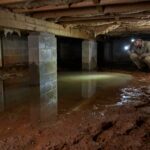Essential Guide to Foundation Repair: Protecting Your Home from Structural Damage
When it comes to the safety and longevity of your home, the foundation is the unsung hero. Just like a sturdy pair of shoes can make or break your day, a solid foundation is crucial for a happy, healthy house. Unfortunately, foundations can face a variety of challenges that might lead to structural damage. But fear not! This essential guide will equip you with the knowledge you need to identify, address, and prevent foundation issues.
Understanding Your Foundation
Before we dive into the nitty-gritty of foundation repair, let’s break down what a foundation is and the different types you might encounter. A foundation is essentially the lowest load-bearing part of a building, providing stability and support. There are several common types of foundations:
1. **Basement Foundations**: These foundations are quite literally below ground level, providing an excellent barrier against moisture but requiring proper drainage to prevent flooding.
2. **Crawl Space Foundations**: Found in homes where soil conditions prevent a basement, these foundations elevate the house above the ground with a small accessible space underneath.
3. **Slab Foundations**: Popular in warmer climates, these are made from a single layer of concrete poured directly on the ground.
4. **Pier and Beam Foundations**: Elevated off the ground with piers, this type uses beams to support the home’s structure, allowing for easier ventilation and access to plumbing.
Each type has its own set of potential problems, but they all share one common enemy: water. Yes, our dear friend H2O can cause havoc if not managed properly.
Signs of Foundation Problems
Detecting foundation issues early on is more critical than spotting your neighbor’s bad haircut. Here are some signs that your foundation may need repairs:
– **Cracks in Walls**: Thin cracks in drywall are usually nothing to lose sleep over. However, if you see large cracks or gaps where two walls meet, it might be time to investigate further.
– **Uneven Floors**: If your morning stroll across your living room starts to feel like a downhill trek, your floors may be settling unevenly due to a compromised foundation.
– **Doors and Windows Misalignment**: If your doors suddenly decide to start playing hard to get—sticking, swinging open on their own, or otherwise behaving badly—it could indicate that the foundation is shifting.
– **Water Accumulation**: Puddles forming near your foundation after a rainstorm? That’s not a picturesque pond; it’s a sign that drainage issues may be at play.
– **Bowing Walls**: If you notice any walls that seem to be bowing inward or outward, that is a definite call for action.
If you spot any of these signs, don’t panic! Much like a medical check-up, addressing foundation problems early can save you a heap of trouble (and cash) later.
Common Causes of Foundation Damage
Now that you’re aware of the tell-tale signs of a crumbling foundation, let’s explore what might have caused those cracks to form akin to your high school math test anxiety.
1. **Poor Drainage**: Improper drainage can lead water to pool around your home, infiltrating the foundation and causing it to weaken.
2. **Soil Issues**: Different types of soil expand and contract with moisture levels. Clay-rich soils, for instance, can soak up water and swell, lifting your foundation, whereas sandy soils can dry out and shrink, leaving your foundation to settle.
3. **Tree Roots**: While trees are great for shade and aesthetics, their roots can undermine your foundation, especially if they’re thirsty for moisture and extend near your home.
4. **Extreme Weather Conditions**: Heavy rains, droughts, or freezing temperatures can wreak havoc on your foundation. Mother Nature can be both your friend and foe, and navigating her whims can be tricky.
5. **Construction Defects**: Sometimes, foundation problems arise from poor construction practices or materials – kind of like when you buy what you think is a designer handbag, only to find it’s a knockoff.
Addressing Foundation Issues
So, what should you do if you’re facing any of these problems? You’ve got options, and luckily, many of them don’t involve a shovel and a lot of dirt under your nails.
1. **Consult a Professional**: The first step to addressing foundation issues is contacting a professional foundation contractor. They can assess the damage, provide solutions, and ensure your home stays safe. Remember, the right expert can make all the difference – much like a good cup of coffee on a Monday morning!
2. **Repair Types**: Depending on the severity of your foundation issues, there are various repair methods available:
– **Crack Injection**: For those pesky cracks, epoxy or polyurethane foam can be injected to seal and restore structural integrity.
– **Piering**: This method involves installing piers under your foundation to lift and stabilize it, correcting any settlement issues.
– **Underpinning**: Similar to piering, underpinning is used to strengthen the foundation by extending it deeper into stable soil.
3. **Install Drainage Solutions**: Proper drainage is key in preventing future issues. Consider installing gutters, downspouts, and drainage systems to redirect water away from your foundation.
4. **Soil Grading**: Regrading your property to ensure proper water flow away from the foundation can work wonders. It’s like giving your home a nice hat that directs rain away rather than letting it puddle around its feet.
5. **Monitor Your Home**: After repairs are done, keep an eye on your foundation for any new signs of distress. Early detection of problems can save you significant time and money in the long run.
Prevention is Key
As they say, an ounce of prevention is worth a pound of cure, and when it comes to your foundation, that couldn’t be truer. To prevent future foundation issues, consider the following strategies:
– **Regular Inspections**: Schedule routine inspections of your foundation and surrounding land to catch potential issues early.
– **Maintain Landscaping**: Keep trees and bushes trimmed and far enough away from your foundation to prevent root invasions.
– **Manage Water Flow**: Ensure your gutters are clean and functioning, and adjust downspouts to direct water away from the base of your home.
– **Fix Plumbing Leaks**: If you have any plumbing issues, address them immediately to prevent excess moisture around your foundation.
In Conclusion
Your home is your sanctuary, and its foundation deserves just as much love and attention as the décor, the appliances, and even the fuzzy throw blanket on your couch. By understanding the signs of foundation problems, knowing how to address them, and taking preventive measures, you can preserve the integrity of your home for years to come.
Remember, foundation repair might not be as glamorous as choosing paint colors or finding the perfect couch, but it’s a fundamental part of maintaining your castle. And who knows? With the right care, your foundation will hold strong, just like that commitment to finally tackling those home improvement projects—you can do it!


